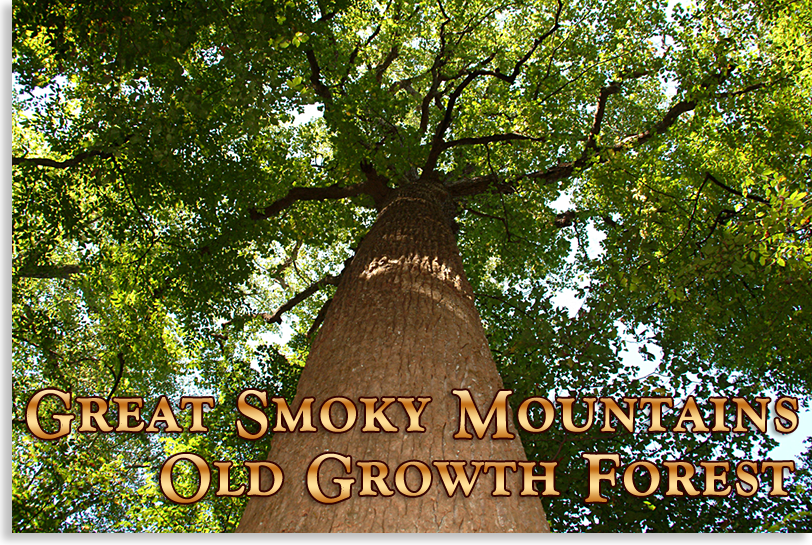
The Tress That Saved A Forest
Smoky Mountains National Park Old Growth Forest
In the early 1900's when our nation was searching for ways to preserve our heritage and protect our natural wonders and environment a national park was being proposed for the eastern regions of the United States.
Most national parks were located out west, far away from the greater population that resided in the eastern states of America. Several locations across the southeast were being proposed by its citizens feeling their region had the most unique geographical setting for the new national park.
It was common knowledge that the chosen location would cause a fervor of excitement to local communities and speculators seeing a profitable venture in their midst. Yet the decision as to where a national park should be established wasn't solely about economics and wilderness beauty. The decision would be made based on conservation, preservation and protection. The region that was getting the most attention was the Blue Ridge Mountains; the natural wonders within its boundary were outstanding examples of what our nation had to offer for its first eastern national park.
After a long process of meeting with local groups and intense physical examination of so many wonderful prospects, it was finally concluded as to which region would be taken the most seriously for consideration. With diligent and persistent persuasion from a group base in Knoxville Tennessee and one determined writer named Horace Kephart that lived on the southern North Carolina side of the Smokies, it was finally decided that the Smoky Mountains of Eastern Tennessee and Western North Carolina would carry the honor as the fist national park of the eastern United States, and become the Great Smoky Mountains National Park.
Even though the Smoky Mountains were the largest, broadest and most remote mountain range in the east, the choice wasn't solely made for that reason. It wasn't chosen because Clingmans Dome was the tallest mountain top in the east, that title rightfully went to Mount Mitchell of North Carolina, coming in at a height of 6,684-feet which slightly over shadows Clingmans Dome at 6,643-feet, making it the second highest mountain in the east.
The Smoky Mountains weren't selected because of its great watershed consisting of 700 miles of trout streams and waterways, the Blue Ridge Mountain Province itself contains a vaster amount of a precious watersheds. It wasn't the only choice when it came to how deep the gorges and runoffs were in the Smoky Mountains, there are greater river gorges throughout the mountains, such as Linville Gorge, Nantahala Gorge, Pigeon Gorge, Ocoee Gorge and Tallulah Gorge to mention a few.
Maybe it was the flora and fauna of the natural wildlife that set the decision into motion as to where the new park should be established. The Great Smoky Mountains National Park does preserve and protect its wildlife, although similar wildlife is scattered throughout the Blue Ridge Mountain Province, often protected through state parks and wildlife management programs.
So what was that final determining factor that set into motion the Great Smoky Mountain region to be the first in conservation and preservation?
It became a simple choice, a choice that was heavily weighing on the consciousness of many Americans who once knew this land as pristine and abundant in unlimited natural resources. The greatest of those natural resources was timber, a commodity in demand that was being clear-cut at an alarming rate.
Whole mountainsides were disappearing under the saw, threatening the watersheds and natural wonders that shaped these ancient mountains. The thirst for timber by a young expanding nation was in a fevered pitch with no stop in sight.
By the early 20th century the US Agricultural Department was buying up some of these clear-cut timber wastelands. Timber companies were moving from site to site first increasing the local economy then leaving it in waste as they frenzied across the mountains slopes, ridge tops and deep coves. High profits were driving most of these timber barons with one idea only "get it before the next guy does," a madness and lack of concern for the environment was powering the destruction.
Thank goodness one of these timber men became the silver lining in the face of the storm, George W. Vanderbilt, a forefather of our National Forest Service. For more about G.W. read link to stories.
It is estimated that as much as 80% of the timber of old-growth forest had been removed by the 1920's with no stop in sight. Small stands of old-growth forests still existed at the timed scattered throughout these mountains, the only thing stopping the loggers were access and the ability to remove. Newly constructed rail lines were being laid as fast as humanly possible, the only protection these remaining stands of old-growth forest had were the extremely difficult mountain terrain that slowed down their demise. With modern know-how and man's insatiable desire to conquer the wilderness it was only a matter of time before these old growth fell to the saw. Their motto was the sooner this land was conquered the better; there was a great vast forest lying in wait out in the western United States ripe for the picking. It was a race against time and machine to grab all the forest had to offer before someone caught on and the government interfered.
With the newly founded National Forest Service buying up mountain land fairly cheap because the lumber barons left nothing but saplings behind. It was now the forest service's monumental task to replant the forest and restore the precious watersheds; it also became a priority to search out and save the old-growth forest wherever they could.
There were reports during this time of large tree stands of old-growth forest that still lay in the more difficult reaches of the Smoky Mountains. The problem was these land tracts of forest were in the hands of timber companies that weren't going to let go very easily. In time they did yield to the government demand for conservation and preservation but only after the timber companies were paid a premium for the standing timber.
Today the Great Smoky Mountains National Park has within its boundaries over 100,000 acres of old-growth forest scattered throughout its parkland's 521,000-acres of land to be maintained, preserved and protected for the posterity of our nation and its people.
Now under the watchful eyes of the Forest Service, enormous trees dating back four centuries or more rise along the slopes, ridges and coves of this unique national park. These trees are a life giving, growing ever-expanding wonder within themselves, reflecting the pride and honor these ancient mountains have to offer. All set within a natural protected biosphere for the enjoyment of those that wish to see, touch and stand in amazement of one of God's greatest creations.
Yes the Great Smoky Mountains National Park is a wonder of nature standing before us, welcoming visitors into its sacred sanctuaries, preserved for the sake of time itself as an example of the natural wonders that exist for all those wanting to enjoy its splendor.
When it comes to the Smoky Mountains and all its magnificent grandeur it's truly the trees that saved the forest and all the wildlife held under its loving care. It's the trees that protect the precious watershed of these mountains that feed our rivers and lakes providing refreshing nourishment to the people, wildlife and fields of this great nation. Revere the mountains yes, yet protecting the forest is what holds the mountains together and fills our lungs with the breath of life.
Visitors can visit some of these great old-growth tree stands by hiking deep into the Smokies interior. An easier way to experience the awe and wonder of the mighty trees is following the Newfound Gap Road to the Chimney's picnic area, 4.4-miles south of Sugarland Visitor's Center. Here you can take the 3/4-loop along the Cove Hardwood Nature Trail and experience a personal view of these awe-inspiring giants of the forest. Other access to these giants can be found along the Albright Grove Loop Trail, and the Ramsay Cascades Trail. Take time to stop in at the Sugarland and Oconaluftee Visitor's Center to learn about other old-growth forest and their location within the national park.
It's not a matter of "you can't see the forest for the trees." It's a matter of "you can't have a forest without the trees." Wood harvested from trees serve our need for human expansion and growth, yet when it comes to trying to live without air and fresh water resources trees are the key to our survival.
The next time you visit the Great Smoky Mountains National Park and other regions of the Blue Ridge Mountains take time to give thanks, because only God can make a tree.
For other locations of old-growth forest in the Blue Ridge Smoky Mountains regions check out the Blue Ridge Highlanders magazine section under the Giants of the Forest, which include a visit to Joyce Kilmer Memorial Forest, which is celebrating its 75th anniversary on July 30, 2011. The Blue Ridge Highlander will be there for this remarkable acknowledgement of nature's grand achievements. Plus check out the Highlander's coverage on Chimney Rock at Chimney Rock State Park's protected old-growth tree stand.
When one stands so small at the base of one of these great giants of the forest I guess one should say things are looking up in the Blue Ridge Smoky Mountains.
The Highlander,
Other Giants of the Forest Editorials
Visit Joyce Kilmer Memorial Forest • Joyce Kilmer - Patriot Poet
History of Joyce Kilmer Memorial Forest • Nearby Points of Interest
Chimney Rock at Chimney Rock State Park
![]()
Sign
up for the Blue Ridge Highlander Newsletter, Messages from the Mountains
to find out first about our new feature stories, road trips and special offers
Your e-mail addresses will not be sold or given away to anyone.
Privacy
Policy
Interested in your business being on the Highlander, click here...
Let our visitors tell you about the Highlander...
Click the feathers to go to the Highlander site
map...

